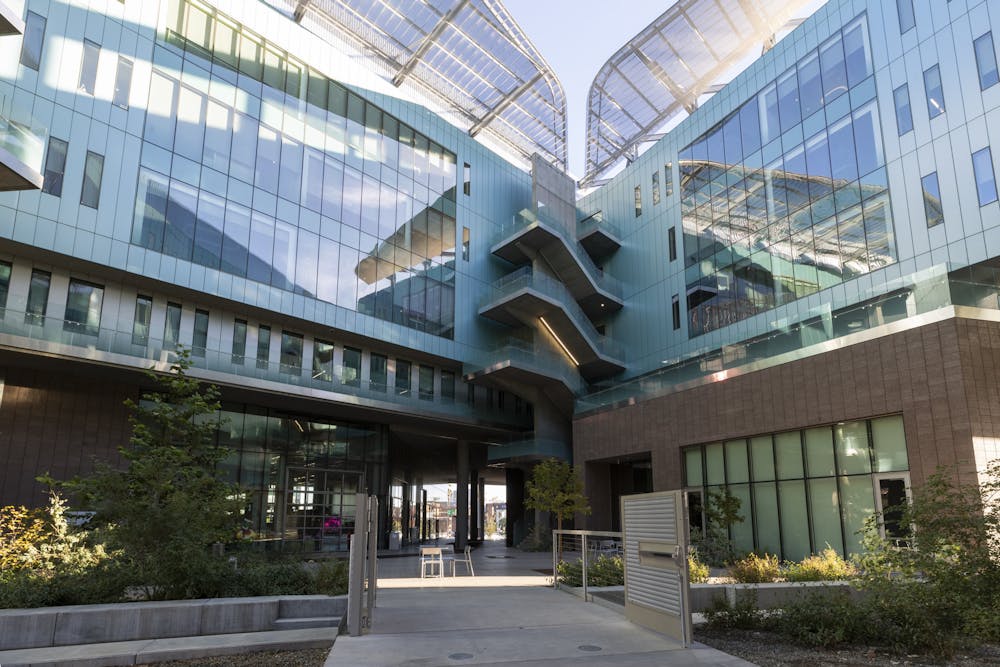"University" is a word that may evoke a "Hogwarts-like" imagery, with thoughts of a campus featuring a medieval-style library, Gothic-inspired castle towers and pristine chapel-like architecture. At least, that's the feeling many American universities seem to give off, but not ASU.
ASU is known for its "modern" Tempe campus, where buildings look less cohesive, intricate and Gothic-inspired and are often more plain and structured. It doesn't have sky-scraping watchtowers or Renaissance-styled libraries. Instead, it has the more contemporary study spot, the Hayden Library and the Memorial Union, a gathering place that resembles a mall.
"ASU is a very interesting case," said Elena Rocchi, program head and clinical associate professor of architecture at The Design School. "I see ASU’s campus as more brutalist because it is showcasing prefabricated pieces in concrete."
With a campus dating back to the 1890s, ASU has become a collection of constantly evolving buildings and styles.
"There's a hybrid version like ASU is," said Marc Neveu, co-director for the Center of Building Innovation and professor of architecture at The Design School. "Tempe and ASU were intertwined at one point, and ASU grew out and overtook a number of roads; it’s a campus that is urban but not really. It's become its own place."
So, what makes universities like Harvard and Yale feel "Hogwarts-like," whereas ASU does not?
"Harvard and Yale are modeled after British universities, where you have a series of yards, and everything is centered around those yards," Neveu said.
ASU is a unique campus because it does not fit a specific category. It's not urban because it does not intertwine with the city but does not revolve around yards, like Ivy League schools. ASU is different as it doesn't have those public spaces and isn't gated, which gives a different feel, according to Neveu.
For some students, ASU's varying architectural style stands out. ASU boasts a very outdoor-based campus, so trees and sun are the main things you experience as you go from building to building.
"When you are at (the University of Washington), you're very drawn to the nature of the architecture because you spend most of your time inside," said Evie Hoff, an ASU freshman studying sports business who has spent a lot of time on the UW campus. "(At ASU), the buildings are built so that a lot of the time, you are outside."
The reason behind this architecture may be Arizona's climate. With scorching summers and relatively warm winters, the sun is a constant light source in Tempe.
"(The architecture) is determined by the issue of climate," said Rocchi. "That's why it's very closed and less glassy. They are trying to be introverted."
Introversion on the campus helps keep the heat outside, while plants and other sources of cool climate stay inside. Rocchi pointed out two "twin" buildings on campus: the Social Science and Farmer Education buildings.
"They are built with an inner courtyard," said Rocchi. "My favorite buildings have a lot of life inside. There's an inner piazza; you can take a shortcut through those buildings if you know your way around."
READ MORE: 5 Hidden Study Spots on ASU's Tempe Campus
A building boasting a new style of architecture on campus is the glassy Rob and Melani Walton Center for Planetary Health. However, according to Rocchi, the number of glass buildings on campus is limited because of the expense of air conditioning.
"It's not modern, but it's contemporary," Neveu said about the Walton Center. Contemporary architecture describes how the building presents a more current and advanced technological style.
Even with varying architecture, some architecture on campus hints back to the buildings of British universities, including the renowned "Harry Potter room" inside the Mark Jacobs Dining Hall in Barrett.
Hoff said that the Barrett dining hall reminds her of the library at UW.
"It has that same charm to it with that traditional feeling," Hoff said.
With ASU's campus being much less cohesive and more dependent on various styles, the incredibly unique architecture is often overlooked in favor of Ivy League-like architecture.
But take a look around. From the Gammage Auditorium designed by Frank Lloyd Wright, to Old Main in the 1800s, ASU is a tapestry of the different kinds of architecture that can be combined to create a rich and beautiful campus.
"It feels different," said Hoff. "That's the only word I can think of. It's not a bad feeling, but ASU creates a different atmosphere with so much going on."
Arizona State University: Maybe not your typical imagined "Hogwarts-like" campus, but it is home to students — including us.
Edited by Sophia Braccio, Walker Smith and Grace Copperthite.
Reach the reporter at gachatht@asu.edu.
Like The State Press on Facebook and follow @statepress on X.
Gokul Achaththekoot is a junior majoring in actuarial science at ASU. He is involved with on-campus sketch comedy, and enjoys learning more about the community and culture of ASU. This is his 5th semester at The State Press, having served on The Echo as a part-time reporter in all his semesters here.




